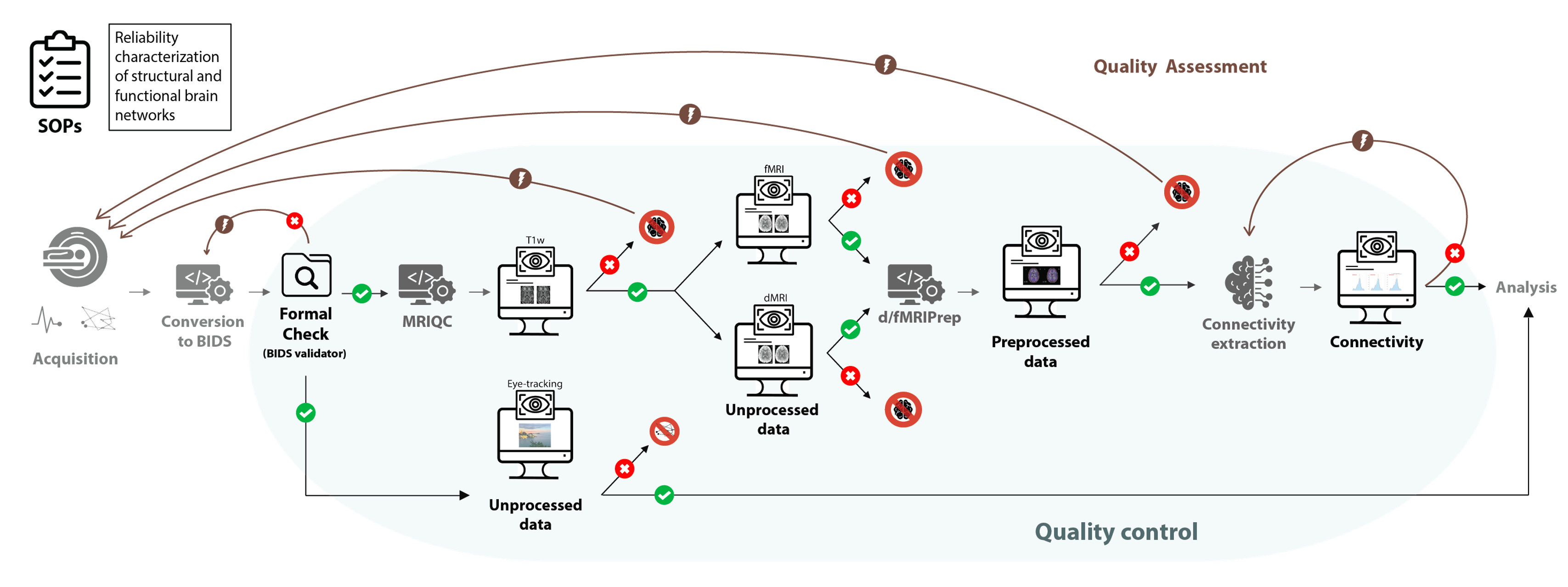General QA/QC protocol¶
Following our protocols1 and best practices2, we establish quality checkpoints after the outstanding stages of our neuroimaging pipeline. That is, we establish checkpoints after the conversion to BIDS, on the unprocessed (before preprocessing) data, on the preprocessed data, and further downstream, for instance, following FC extraction. Our QA/QC can be summarized as follows (click here to see it full size):

Immediately report errors or quality issues encountered
If errors or quality issues are encountered, find the issue corresponding to that session in the dataset's repository and report a comprehensive description of the problems.
As we previously emphasize in our protocol1, QC exclusion criteria are defined and graded corresponding to the experimental design.
Individual and group visual reports¶
Following the NiPreps guidelines and best practices, quality checkpoints are implemented with visual reports that are released alongside the data and analyses. These visual reports contain several atomic views (meaning, a single quality facet of the data or a particular processing step), which we call reportlets, that together allow the curator assess the quality. These visual reports are formatted as HTML documents, and therefore they are presented linearly. Google Chrome is the preferred Web Browser to open the HTML reports. The following admonition will be found at several places of this protocol to suggest that visual reports can be navigated freely to ensure all aspects of quality have been properly assessed:
It is RECOMMENDED to jump back and forth through sections while screening the visual report.
Assessment of functional MRI¶
The reliability protocol includes two tasks (QCT and BHT) before the RSfMRI run. This design tries to leverage these two runs as a quality proxy for the RSfMRI. The following admonition will be present to remind this strategy when it applies:
IMPORTANT — QCT and BHT are assessed first as proxies for the RSfMRI run's quality.
We employ the QCT (mainly) and the BHT as proxies for the quality of the RSfMRI run. Screening the reports in the prescribed order (QCT — BHT — RSfMRI) helps identify issues in the QCT and BHT that may anticipate problems in the RSfMRI.
Consistently with this approach, the exclusion criteria for the QCT and the BHT at the different QC checkpoints are very permissive. The following admonition will remind this aspect when it applies:
IMPORTANT — QCT and BHT runs with low quality MUST be flagged, but they SHOULT NOT be excluded.
The BHT and QCT were primarily acquired for QA/QC purposes and to aid in methodological development (e.g., denoising of the RSfMRI). This QA/QC protocol should be revised if the task fMRI data are employed for different purposes.
Quality assessment versus exclusion criteria¶
The QA/QC criteria for some checkpoints are split in two different categories:
- On the one hand, QA criteria instruct how to change the processing of the data in case the criteria are not met.
- On the other hand, exclusion criteria instruct when scans or sessions need to be excluded because of their insufficient quality.